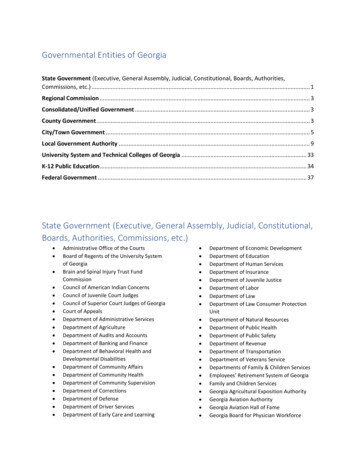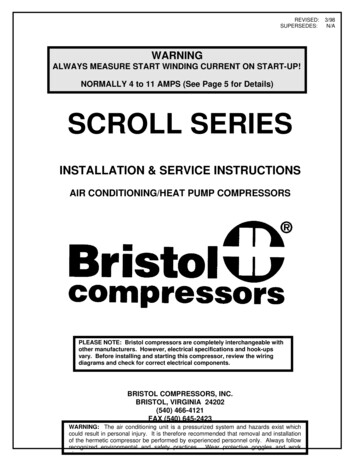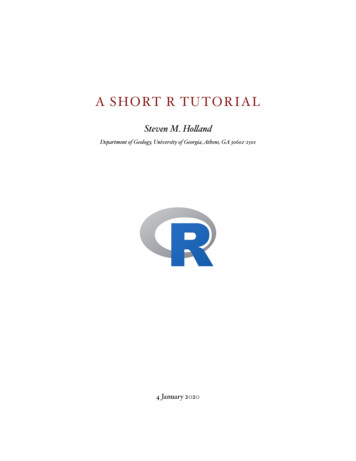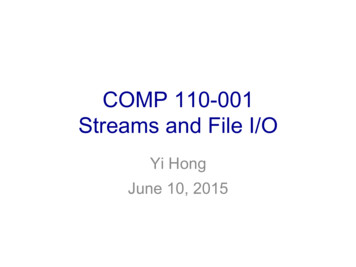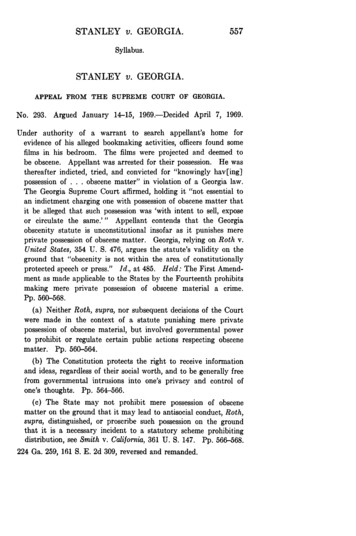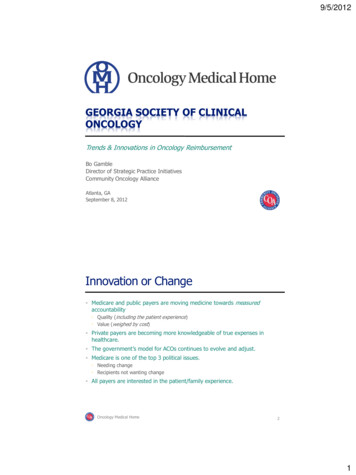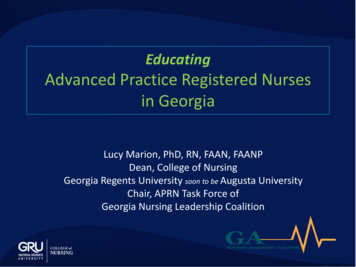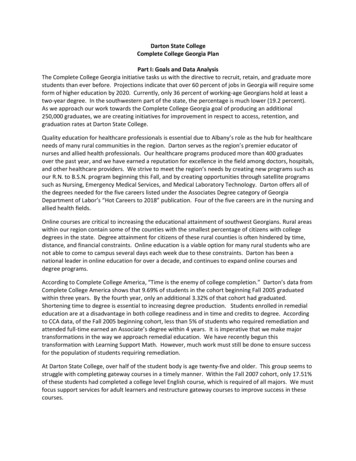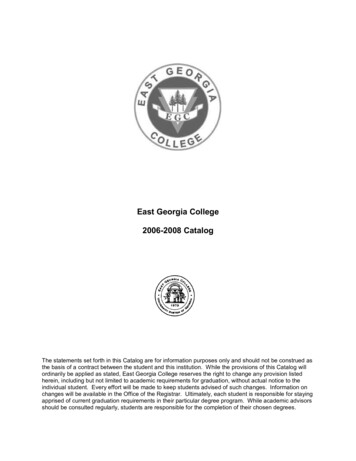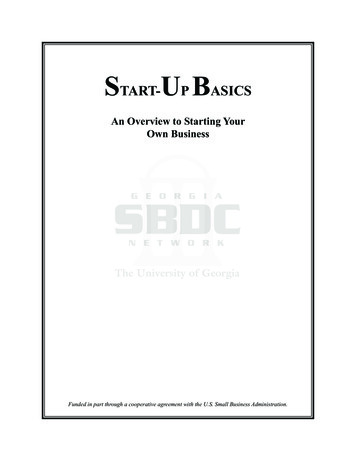
Transcription
START-UP BASICSAn Overview to Starting YourOwn BusinessFunded in part through a cooperative agreement with the U.S. Small Business Administration.
IntroductionThis manual is a publication of The University of Georgia Small Business Development Center.Business consulting, information, and publications are available through the SBDC network officeslisted at the end of this publication.The SBDC program is designed to provide quality business and economic development assistance tobusinesses and prospective businesses in order to promote growth, expansion, innovation, increasedproductivity, and improved management. These objectives are accomplished by providing one-onone consulting and business training programs, assisting clients with exporting and procurement,supporting minority business development, conducting applied economic research, and fosteringrural development.This material is designed as a step-by-step introduction to the issues every new business must face.Our primary goal is to present a “way of thinking” that will help you plan, start, and successfullyoperate your business. Short cuts are not recommended.Business consultants are available for individual conferences, but your advanced preparation isrequired. Please complete the “Business Development Questionnaire” (BDQ) located in the appendix and mail the results to the office most convenient to you. The approach presented in thiskit will help you complete the BDQ and evaluate various business decisions.If you decide to pursue your idea, completion of a detailed business plan will probably be the nextstep, and the network of SBDC consultants can assist you. The preliminary work covered in thismanual will put you well on your way toward an effective business plan.Thank you and good luck.
Table ofContentsSTEP 1:Is My Business Idea Feasible?. .1Ask Yourself Some Tough QuestionsResearching Your MarketBreak-Even AnalysisSTEP 2:Operating Legally.4An OverviewInformation Sources for BusinessSTEP 3:Building Your Team.12STEP 4:Financing Your Business.13How Much Money Do You Need to Start This Business?Steps in Financial ProjectionsWhere Do I Get the Money?STEP 5:Pulling It All Together.17Why Write a Business Plan?Business Plan Outline
STEP 1: IsMy Business Idea Feasible?Ask Yourself Some Tough Questions.Do you have what it takes to start your own business? Many people feel that they only lack themoney to start or only need help with the legal and tax issues, but these are just a few of the considerations entrepreneurs need to address. The following are a few of the questions every newentrepreneur should consider. When answering these questions, think of an example.oDo I have confidence and optimism about my ability to overcome obstacles?oDo I accept responsibility for my actions?oDo I like being in charge?oAm I able to function in an environment of uncertainty?oAm I able to motivate and inspire people?oAm I an effective salesperson?oAm I a fair negotiator?oDo I understand my own limitations and know when I need to ask for help?oAm I easily discouraged?oAm I willing to devote whatever time and energy it takes to be successful?oIs the risk of my financial assets worth the expected rewards?oDo I have a history of success at things to which I am committed?oDo I have a strong support group of family and friends?Is My Business Idea Feasible?1
Researching Your Market(This information will help you complete the MARKETING section of the BDQ.)Many businesses will require some outside research to estimate the demand for products/services.This is especially true if you do not have extensive experience in your new venture. Start by listingthe questions you need to research (see marketing section on BDQ). Listed below are some ideasfor where to find answers to your questions. (Be creative and determined.)Secondary Data: Internet Public libraries (see your reference librarian for the sources that will best fit your needs). Prospecting lists/directories. Market studies, industry information. Computer assisted periodical searches. Competitor, supplier information. Economic forecasts. Trade associations - trade journals and trade shows. SBDC, SCORE, colleges and universities.Primary Data: Your experience, people you know in the industry. Survey prospects to determine what they want. Observe and interview similar businesses (especially outside your trade area). Suppliers, vendors, and bankers. Employ students or interns to conduct surveys.2Is My Business Idea Feasible?
Break-Even AnalysisBreak-even (B/E) analysis is a simple, but very effective financial feasibility test. B/E is used todetermine the amount of sales necessary to pay all fixed costs (and have zero profit). Follow thesesteps:1Determine Gross Profit Percent. Gross profit equals sales minus cost of goods sold.2List and Total all Fixed Expenses. Expenses which do not rise or fall with sales3Break Even Sales is Fixed Expenses divided by Gross Profit Percent. (SeeGross profit percent equals gross profit dollars divided by sales. Note: Cost of Goods Sold(CGS) is a variable expense, including materials and labor necessary to make an item readyfor sale. If a business (like consulting) has no CGS, then gross profit percent is 100 percent.volume - rent, insurance, utilities, etc.example below.)Per Unit Sales Price: 10Cost of Goods Sold:Materials3Labor1Total CGSGross Profit %Fixed Expenses:Rent 2,000Utilities 1,000Salary 3,000Other 4,000 4Total Fixed Expense60% (6/10)B/E Fixed ExpenseGross Profit %B/E 10,000.6Is My Business Idea Feasible? 10,000B/E 16,6673
STEP 2: OAn OverviewperatingLegallyBEFORE you start. Select the legal form for the business (soleproprietorship, corporation, partnership, orlimited liability company). Apply for federal and state employer taxidentification numbers if needed. Obtain the proper licenses that apply to your business. Apply for workers’ compensation and other insurance through private insurance carriers.(Worker’s compensation is required in Georgia for three or more employees regardless ofthe number of hours worked by each employee.) Register a trade name if applicable. Apply for any trade name registration, fictitious name registration, trademarks, copyrights,or patents necessary to protect your assets. Engage and consult qualified advisors in law and taxes as needed. Complete any other steps necessary for the legal formation of your particular business.AFTER you start. Make estimated income tax payments and file tax returns for both state and federal taxes. If you have employees, comply with all state and federal requirements for withholding andpayment of payroll taxes. Comply with all Georgia sales and use tax regulations if applicable. Determine your obligation to pay local property taxes. As your business grows, periodically check requirements that may apply to larger businesses.(The Americans With Disabilities Act and the Family Medical Leave Act are examples.)Note: For more details, see the next section, “Information Sources for Small Businesses.”4Operating Legally
Information Sources for Business(Revised 11/05)This information is not all-inclusive and should not be considered a substitute for assistance fromqualified legal and accounting professionals. Since these requirements are subject to change, prospective business people should contact the appropriate local, state, and federal departments forthe latest information.Legal FormDetermine the legal form of business best for your situation:4444Sole ProprietorshipPartnershipCorporation (“C” or “S”)Limited Liability Company (LLC)Your decision is based on issues of liability exposure, taxes, the number of owners involved, andfuture expansion plans. It is advisable to consult an attorney, CPA, or financial consultant for helpin deciding which legal form of business best suits your situation. The legal form you choose willaffect many of the steps that follow.Sole Proprietorship:This type of business is easiest to form; an individual starts the business in his or her ownname. Personal and business activities are not distinguished.Partnerships:A partnership is a relationship between two or more people who join to carry on a trade orbusiness. Each person contributes money, property, labor, or skill and expects to share inthe profits and losses of the business. A formal, written partnership agreement is stronglyrecommended, but not required.Operating Legally5
Corporations:You must contact the Georgia Secretary of State, Corporations Division, at 404-656-2817to register your business as a corporation.Basic Steps:4Reserve the corporate name.4You will receive written notice and have 90 days to complete the incorporation.4File the articles of incorporation.4Complete the transmittal form.4Send articles, transmittal, and check to the Secretary of State’s office.4Publish intent to incorporate in the county’s official paper; call for current fee.4Hold organizational meeting. Adopt by-laws. Elect directors. Elect officers. Issue stock.There are a number of “corporate kits” containing pre-printed by-laws, minutes to shareholders meetings, blank stock certificates, etc., that are available at office supply stores. Itis the duty of the corporation’s secretary to maintain the corporate record book of minutesof meetings, corporate resolutions, and other business decisions of the board of directors.Corporations are also subject to annual registration with the Secretary of State which costsa small fee and is required by April 1 each year.There are many “do-it-yourself” incorporation guides, and it is possible to incorporate withoutan attorney; however, the SBDC recommends seeking legal counsel when incorporating.To form an “S” Corporation, you must file IRS Form 2553 within 75 days of incorporation.Limited Liability Company (LLC):This is a legal form of business which combines elements of a “C” corporation and a partnership. This is a complicated form of business to establish, and we recommend you seekassistance from a lawyer.6Operating Legally
Employer Identification NumberObtain federal employee identification number (EIN) if needed. Use IRS Form SS-4. ContactInternal Revenue Service, 1-800-829-4933 toll free or www.irs.gov.You need an EIN if your business meets any one of the following:4444The business is a corporation, partnership, or LLC.You have employees.You have a Keogh Plan.You file one of these tax returns: excise; fiduciary; or alcohol, tobacco, and firearms.A sole proprietor with no employees and none of the other items listed above does not need an EIN;the business owner’s social security number is the business’s tax number.Business Tax Certificate in Lieu of “Business License”You must obtain a tax certificate in the county where the business is located. (Note: If your business is within the city limits, check with the city government. Some cities issue business licenses.)It may also be necessary to apply for a certificate of occupancy from the local zoning department.Only one tax certificate for a county/city is required to legally operate your business throughoutthe state of Georgia. Fees vary by community.Home-based businesses usually require business licenses. Check for restrictions on home-basedbusinesses relating to signage, noise, visits by customers, etc.Additional state licenses are required for certain businesses like grocery stores, restaurants, schools,establishments serving alcoholic beverages, hotels, nursing homes, motor transport companies, childcare centers, and more. Check with your county business license office or the Licensing BoardsDivision, Georgia Secretary of State, 478-207-1300 or www.sos.state.ga.us.Income TaxesAll businesses are required to pay federal and stateincome taxes. Each business must file income tax returns with both agencies. In addition, businesses maybe required to make estimated payments on a quarterlybasis. The specific requirements will vary dependingon the legal form of the business.Sole Proprietorship:Revenue and expense from business activitiesare reported on the Schedule C and includedwith the Form 1040 individual tax return.Operating Legally7
Partnerships:An information return on Form 1065 is required. Since partnerships are not taxable entities, the business’s income is reported on the partners’ individual returns and taxed at theirindividual rates.Corporations:Because corporations are a separate legal entity, they must file a separate return. “C” corporations use Form 1120 or 1120-A. “S” corporations use Form 1120-S. The “S” corporation does not pay taxes; income of the corporation is reported on the individual returns ofthe shareholders in proportion to their ownership share and taxed at their individual rates.Consult a qualified tax advisor to determine the best status.Employment TaxesBusinesses with employees must withhold state and federal employee taxes and pay employer taxes.Both must be deposited (usually monthly or quarterly) in any federal reserve bank using pre-printedcoupons bearing the employer name and EIN. Quarterly 941 returns must also be filed (either bymail or electronically) listing deposits made in that quarter and indicating any additional amount due.All employers must withhold Social Security and Medicare taxes (the current amount is 7.65 percentof gross pay) and pay a matching amount. This total of 15.3 percent plus the amount of federaltaxes withheld (based on the exemptions claimed on the employee’s W-4 form) are deposited andthen reported on the Form 941 Employer’s Quarterly Federal Tax Return. These percentages canc
Break-Even Analysis Break-even (B/E) analysis is a simple, but very effective financial feasibility test. B/E is used to determine the amount of sales necessary to pay all fixed costs (and have zero profit).
